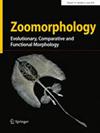Tadpole morphological characterization of Ranitomeya variabilis (Zimmermann & Zimmermann, 1988) (Anura: Dendrobatidae), with skeleton, muscle system and inner organs
IF 1.1
4区 生物学
Q4 ANATOMY & MORPHOLOGY
引用次数: 0
Abstract
Abstract In this study, we morphologically examine larval specimens of Ranitomeya variabilis , which were breed in captivity and genetically determined to belong to the French Guiana population. We provide detailed data on the external morphology, chondrocranium, cranial muscle systems and inner organs of the tadpoles. Additionally, we provide essential characteristics for the recognition of the tadpoles of the different Ranitomeya species. The external morphology of the R. variabilis tadpoles was assessed by measurements and photographs of the specimens. Internal morphology was analyzed using µCT images, µCT-based three-dimensional reconstructions, and dissection of specimens for organ and muscle descriptions. The majority of the muscle configurations observed herein for larval specimens of R. variabilis are consistent with data presented in previous studies for larvae of other Ranitomeya species. In addition, several of the observed morphological characters are defined for different taxonomic levels within Dendrobatidae, e.g., the reduction of tectal cartilages and the insertion of the M. rectus cervicis on the third or fourth branchial arch. The absence of the anterolateral process of the ceratohyal in Ranitomeya and Dendrobates further strengthens their close relationship, in contrast to the more distantly related Epipedobates and Phyllobates where this structure is present. The absence of the M. levator arcuum branchialium I and II, the M. interhyoideus posterior and the M. diaphragmatopraecordialis might be defining traits for Ranitomeya . The specific characters observed in this study for R. variabilis , are the fusion of the superficialis and profundus portion of the musculus levator longus larvae and the absence of the parotic crista.

变异蛙蛙蝌蚪的形态特征Zimmermann, 1988)(无尾目:石蛙科),有骨骼、肌肉系统和内脏
在这项研究中,我们对变异鼠(Ranitomeya variabilis)的幼虫标本进行了形态学检查,这些标本是在圈养环境中繁殖的,遗传上确定属于法属圭亚那种群。我们提供了蝌蚪的外部形态,软骨颅骨,颅肌系统和内部器官的详细数据。此外,我们还提供了识别不同种类蛙蛙蝌蚪的基本特征。通过测量和照片对变异田鼠蝌蚪的外部形态进行了评价。利用微CT图像、基于微CT的三维重建和解剖标本进行器官和肌肉描述,分析内部形态学。本文所观察到的变异背鼠幼虫标本的大部分肌肉形态与以往其他背鼠物种幼虫的研究数据一致。此外,在不同的分类水平上,还定义了一些观察到的形态学特征,如顶骨软骨的减少和颈直肌在第三或第四鳃弓上的插入。Ranitomeya和dendroates中没有角状体的前外侧突,这进一步加强了它们之间的密切关系,相比之下,远亲的Epipedobates和phylloates则有这种结构。提腹支弓支I和支II、舌间肌后支和膈肌的缺失可能是Ranitomeya的特征。在本研究中观察到的变异大鼠的特征是长提肌幼虫的浅肌和深肌部分融合,并且没有分叉嵴。
本文章由计算机程序翻译,如有差异,请以英文原文为准。
求助全文
约1分钟内获得全文
求助全文
来源期刊

Zoomorphology
生物-动物学
CiteScore
2.20
自引率
10.00%
发文量
31
审稿时长
>12 weeks
期刊介绍:
The journal publishes original research papers, reviews and method papers. While reviews should be designed as comparative surveys, summarizing the current knowledge from an evolutionary perspective, method papers should present new approaches or reviews on methods used in animal morphology. The research papers should be based on morphological investigation of invertebrates and vertebrates at the macroscopic, microscopic and ultrastructural level, including embryological studies.
 求助内容:
求助内容: 应助结果提醒方式:
应助结果提醒方式:


